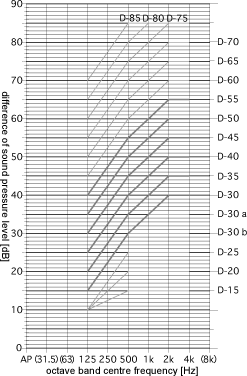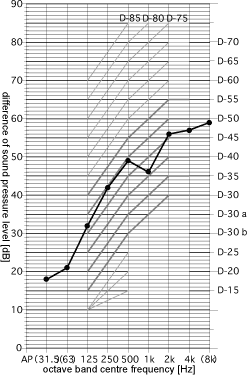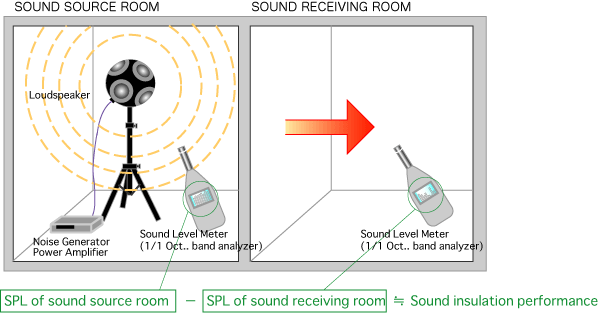|
|
The grading of performance of sound insulation is taken place by using D-Value. D-Value is the class of sound insulation and is stipulated by JIS A 1419: 1992*. The larger numeric value it indicates, the higher performance of sound insulation it shows.
* "Dr" in present JIS A 1419-1: 2000, revised on January, 2001, is comparable to D-value. |
|
D-value is indicated by each 5 step. The larger numeric value it indicates, the higher performance of sound insulation it shows. For example, D-55 indicates that it is higher than D-50 in terms of performance of sound insulation.
D-value between 2 rooms is gained by investigating how much the level of noise in one room decreases in another room with respect to frequency (pitch of sound). The room in which noise occurs is called Sound Source Room, and the other room is called Sound Receiving Room. Find the difference of sound pressure level at each octave band from 125Hz to 4kHz (sound pressure level in Sound Source Room - the one in Sound Receiving Room), and the largest numeric value which does not underrun the standard curved line. And the 2 dB of margin is allowed at each frequency.
JIS regulates the sound pressure levels in the sound source room and sound receiving room are given by the average value of sound pressure levels at five points in each room. But in the case of the measurement of sound insulation performance of doors, windows, not the measurement of room-to-room, the value may be obtained by averaging sound pressure levels at three points at either side of the door or window. |
|
| Example) In the chart below, sound insulation performance outruns the standard curved line of D-45 in ranges other than 1kHz, but underruns that in the 1 kHz range. The result is D-40. |
|
| Special |
extra grade |
Architectural Institute Designated Grade |
very excellent in terms of sound insulation performance |
Applied when high insulation performance is required |
| 1st |
standard |
Recommended by Architectural Institute |
Acceptable in terms of sound insulation performance |
Few complaints from dwellers. No problems. |
| 2nd |
acceptable |
Allowed by Architectural Institute |
Satisfactory in terms of sound insulation performance |
Complaints may come from dwellers. Some troubles in terms of sound insulation performance. Dwellers are almost satisfied with sound insulation. |
| 3rd |
minimum |
Out of Architectural Institute Recommended Level |
Minimum sound insulation performance required |
It is highly possible that there come complaints from dwellers. |




